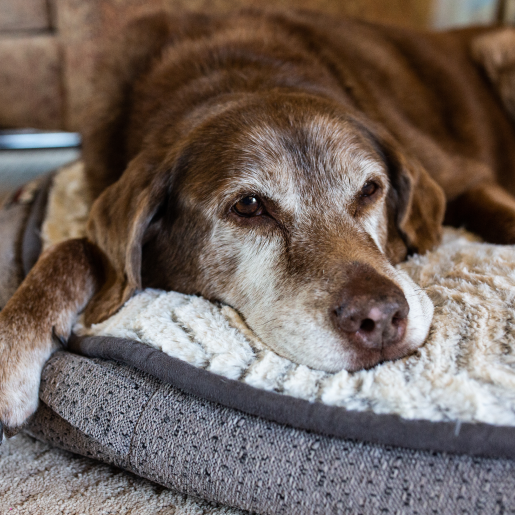Overview
The vestibular system is an important part of an animal’s nervous system that helps with balance and coordination. It lets your pet know where their body is in space and helps control steady posture and smooth movements of the eyes, head, and body.
The vestibular system has two main parts:
- Peripheral Component – This includes parts in the inner ear and the vestibular nerve that sends balance information to the brain. It detects when the head moves or changes position.
- Central Component – This is the area in the brain that receives the signals from the inner ear and processes them. It combines this information with other senses and controls movement to keep your pet balanced and coordinated.
Vestibular disease happens when there’s a disruption in either the peripheral or central system, leading to symptoms such as dizziness, head tilting, and unsteady walking.
Causes
Peripheral Vestibular Disease involves problems affecting the inner ear or the nerve in charge of balance. The most common cause is infections of the middle or inner ear. Additionally, less likely causes include head trauma, certain ototoxic medications, foreign bodies, tumors, or hypothyroidism.
Idiopathic vestibular syndrome is a common condition of unknown origin that affects the peripheral vestibular system. It can occur in dogs and cats of any age or breed, but it is most commonly observed in older dogs. The clinical signs of this condition typically have a sudden onset and may include head tilt, loss of balance, and abnormal eye movements. Despite the dramatic presentation, most animals begin to recover without specific treatment, and symptoms usually improve significantly in 3 to 6 weeks.
Central Vestibular Disease involves dysfunction of the parts of the brain responsible for processing balance and spatial orientation. Possible causes include meningoencephalitis, brain, strokes, or certain toxins.
Clinical Signs
Vestibular disease affects an animal’s sense of balance and awareness of their body position. Common signs you might notice include a head tilt, wobbly or uncoordinated movements, leaning or circling to one side, and sometimes falling or rolling over when trying to stand or walk. You might also see their eyes moving abnormally or appearing misaligned. Because their balance is off, your pet may feel nauseous and even vomit, similar to motion sickness in people.
Diagnosis
Advanced imaging is often recommended to determine the underlying cause of the vestibular dysfunction. MRI can identify any structural abnormalities in the brain and inner ear. Note that inner ear infections cannot be visualized with a standard ear exam alone and require MRI for diagnosis. In certain cases, a cerebrospinal fluid (CSF) analysis may also be recommended.
Blood tests are commonly conducted to identify underlying systemic conditions, such as hypothyroidism. In some cases, blood pressure measurement may be included to rule out hypertension-related causes.
Together, these diagnostic tools help determine whether the vestibular disease is peripheral or central in origin and guide the most appropriate treatment approach.
Treatment
When the underlying cause of vestibular disease is identified, treatment is directed toward addressing that specific condition. For example, ear infections may be treated with antibiotics and hypothyroidism managed with thyroid hormone supplementation.
If the cause remains unknown or in cases of idiopathic vestibular disease treatment focuses on symptomatic relief and supportive care. Anti-nausea medications may be prescribed to reduce discomfort and alleviate motion sickness, and help the animal remain calm. Supportive nursing care is critical during the recovery period. This includes close monitoring, assistance with walking, and frequent repositioning to prevent pressure sores and urine scalding. During the initial phase, pets may have difficulty reaching their food and water bowls. Offering food and water by hand ensures proper hydration and nutrition.
Both at-home and professional physical therapy can improve recovery and prevent complications from prolonged inactivity, especially for animals that are significantly affected.
Prognosis
The prognosis for pets with vestibular disease is generally favorable, particularly in cases of idiopathic vestibular disease. When vestibular disease is caused by a treatable condition, such as an ear infection, the prognosis is also good, provided the underlying issue is addressed promptly and appropriately.
Most animals begin to show signs of improvement within a few days, with continued improvement occurring within weeks to months. A mild head tilt or wobbliness may remain long-term, but these residual signs typically do not impact quality of life.
